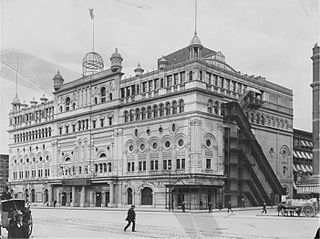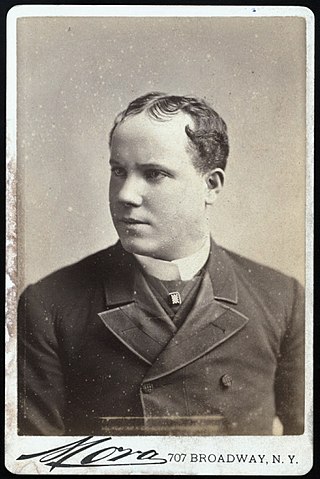Michael Stewart was an American playwright and dramatist, librettist, lyricist, screenwriter and novelist.

Broadway theatre, or Broadway, is a theatre genre that consists of the theatrical performances presented in 41 professional theaters, each with 500 or more seats, in the Theater District and Lincoln Center along Broadway, in Midtown Manhattan, New York City. Broadway and London's West End together represent the highest commercial level of live theater in the English-speaking world.

Edward Harrigan was an Irish-American actor, singer, dancer, playwright, lyricist and theater producer who, together with Tony Hart, formed one of the most celebrated theatrical partnerships of the 19th century. His career began in minstrelsy and variety but progressed to the production of multi-act plays full of singing, dancing and physical comedy, making Harrigan one of the founding fathers of modern American musical theatre.

Stage 42 is a theatre in New York City on Theatre Row, about half a mile west of Broadway. Its address is 422 West 42nd Street, between 9th Avenue and Dyer Avenue. It was built in 2002 and has a seating capacity of 499, counting as an Off-Broadway theatre.

Mechanics' Hall was a meeting hall and theatre seating 2,500 people located at 472 Broadway in New York City, United States. It had a brown façade. Built by the Mechanics' Society for their monthly meetings in 1847, it was also used for banquets, luncheons, and speeches held by other groups.
The American Theater Hall of Fame was founded in 1972 in New York City. The first head of its executive committee was Earl Blackwell. In an announcement in 1972, he said that the new Theater Hall of Fame would be located in the Uris Theatre, which was then under construction, and is now the Gershwin Theatre. James M. Nederlander and Gerard Oestreicher, who leased the theater, donated the space for the Hall of Fame; Arnold Weissberger was another founder. Blackwell ordered that the names of the first honorees "be embossed in bronze-gold lettering on the theater's entrance walls flanking its grand staircase and escalator". The first group of inductees was announced in October 1972.

Palladium Times Square is an indoor live events venue in New York City, located in One Astor Plaza, at the corner of Broadway and 44th Street. It was designed by architect David Rockwell and opened in September 2005. The venue has a large standing room orchestra section, combined with a large area of seating towards the rear of the auditorium.

The Olympia Theatre, also known as Hammerstein's Olympia and later the Lyric Theatre and the New York Theatre, was a theater complex built by impresario Oscar Hammerstein I at Longacre Square in Manhattan, New York City, opening in 1895.

Tony Hart was an American actor, comedian and singer. He is best known for working with Edward Harrigan in the late 19th century comedy team of Harrigan & Hart.
David Braham was a London-born musical theatre composer, most famous for his work with his son-in-law Edward Harrigan (1844-1911), and Tony Hart (1855-1891). He has been called "the American Offenbach".
Canterbury Hall was an edifice located at 663 Broadway in the 19th century. It was used for entertainment and political meetings. It was a three-story building where bawdy concerts took place. The building had a front of 40 feet and a depth of 125 feet.
The American Music Hall, also known as the American Theater until 1908, was one of the oldest Broadway venues. Located at 260 West 42nd Street, it was designed by the architect Charles C. Haight, with a capacity of 2,065. It opened on May 22, 1888.

Charles T. "Charlie" or "Charley" White (1821–1891), was an early blackface minstrel entertainer.

The International Theatre was a theatre located at 5 Columbus Circle, the present site of the Deutsche Bank Center in Manhattan, New York City.

The Garrick Theatre was a 910-seat theatre built in 1890 and located on 67 West 35th Street in Manhattan, New York City. Designed by Francis Hatch Kimball, it was commissioned by Edward Harrigan, who also managed the theatre, originally named Harrigan's Theatre, until 1895. Richard Mansfield took over from Harrigan, renaming it the Garrick. Charles Frohman assumed management from 1896 until 1915. The Shuberts bought it in 1916 and leased it to Otto Kahn, who named it Théâtre du Vieux-Colombier, after a theatre in Paris of the same name. Kahn later gave it to the Theatre Guild and it resumed the name Garrick Theatre in 1919. The Shuberts resumed management in 1925 and the theatre closed as a playhouse in 1929. After a short run of burlesque, the building was demolished in 1932.

The Church of the Messiah at 728–30 Broadway, near Waverly Place in Greenwich Village, Manhattan, New York City, was dedicated in 1839 and operated as a church until 1864. In January 1865 it was sold to department store magnate Alexander Turney Stewart and converted into a theater, which subsequently operated under a series of names, including Globe Theatre, and ending with New Theatre Comique. It burned down in 1884.
The Major is an 1881 comedic play produced by Edward Harrigan and Tony Hart.
The Colonial Theatre in New York City was at Broadway and 62nd Street in what was then the San Juan Hill neighborhood on the Upper West Side, Manhattan. Originally named the Colonial Music Hall, it was opened in 1905 by Frederic Thompson and Elmer "Skip" Dundy. Designed by George Keister, the theater had a seating capacity of 1,293.

Olympic Theatre was the name of five former 19th and early 20th-century theatres on Broadway in Manhattan and in Brooklyn, New York.
Princess Theatre was a Broadway theatre located at 29th Street and Broadway in Manhattan, New York City.












